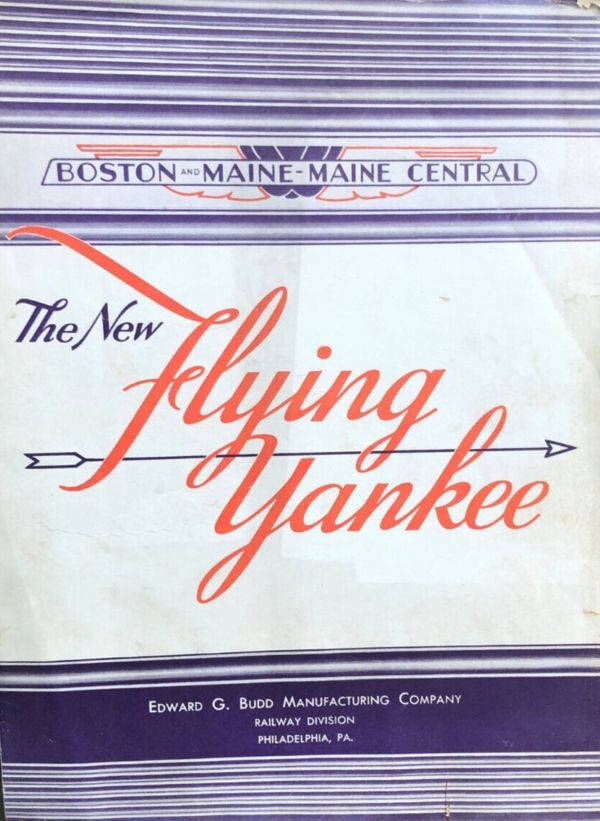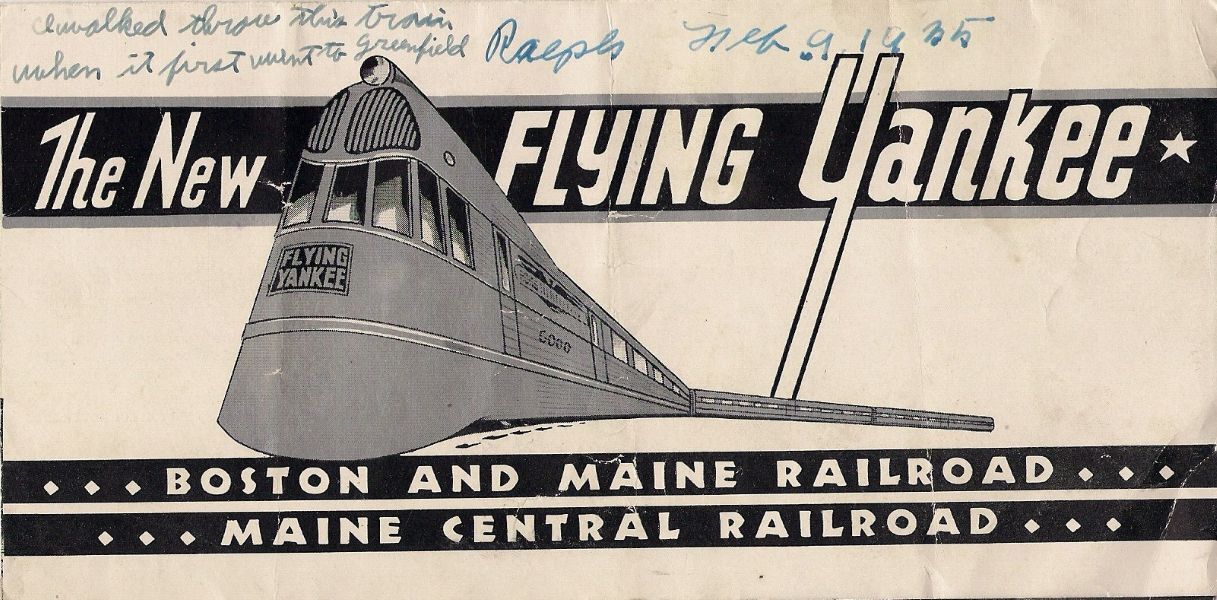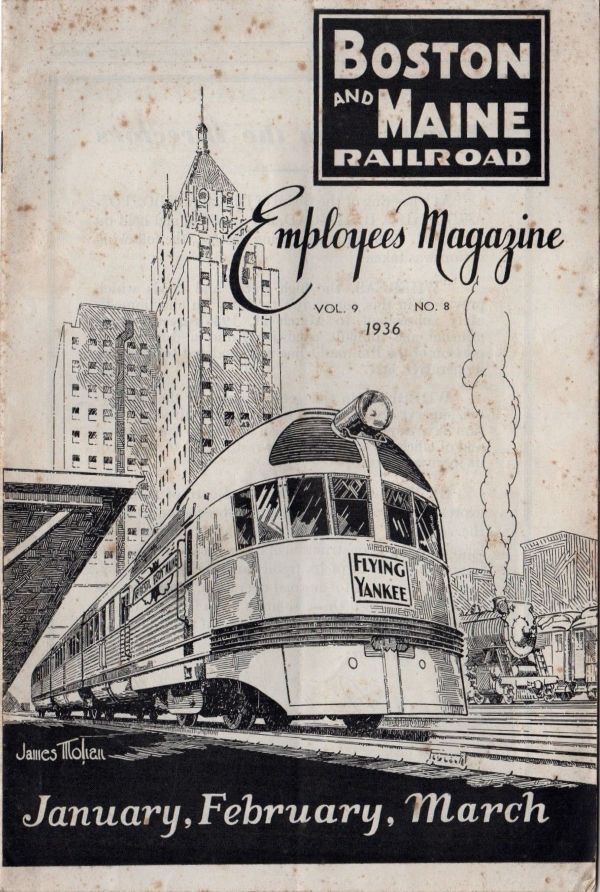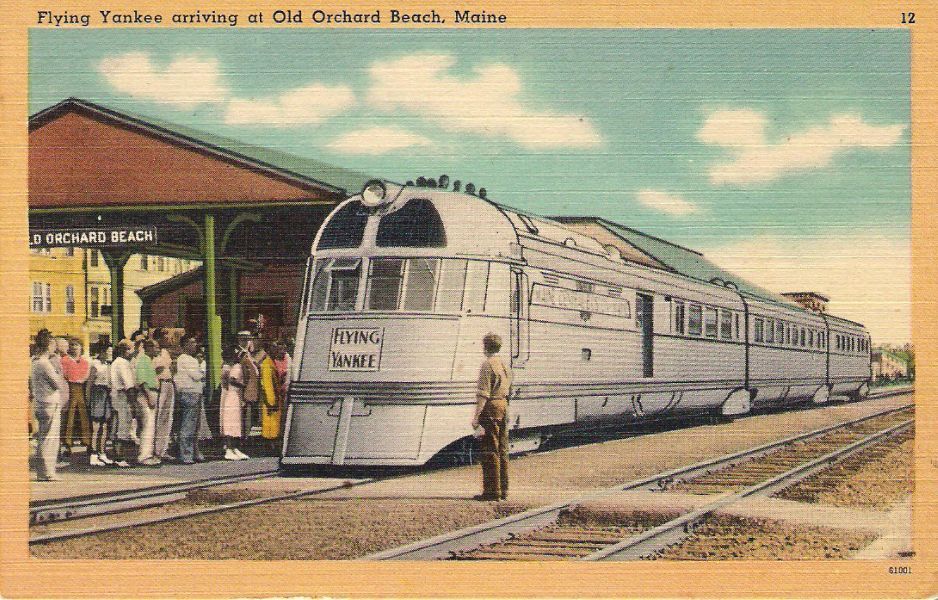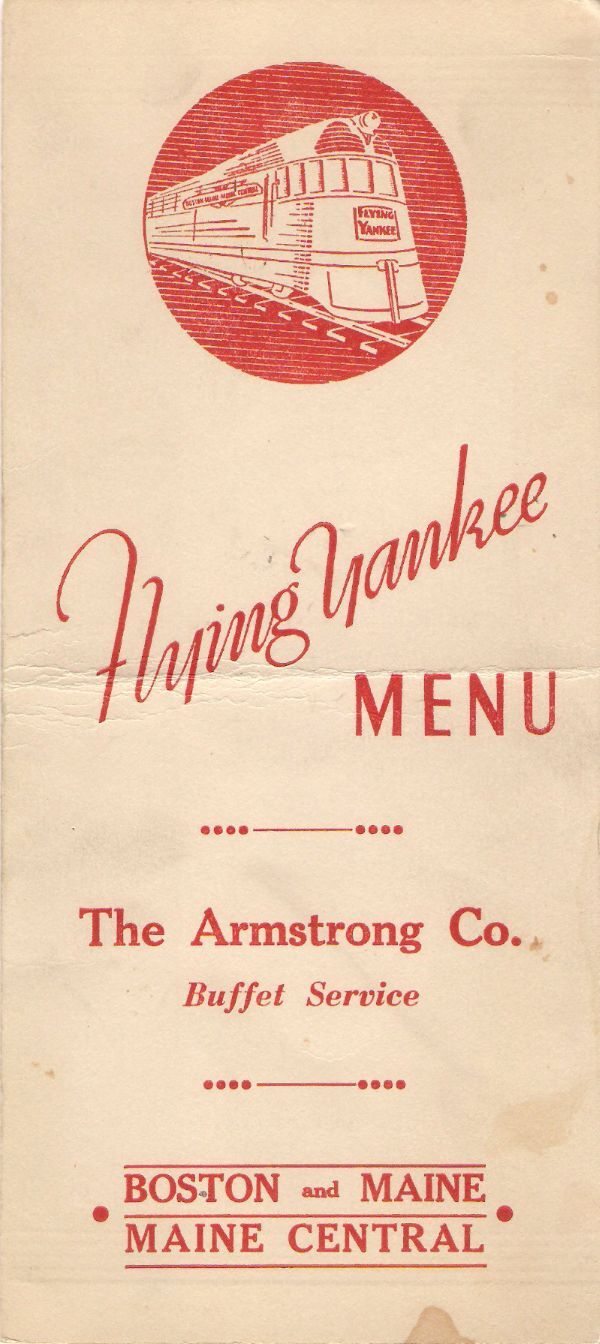SBS4DCC - DCCSound USA - ESU LokSound 5 Flying Yankee Sound File
Last Updated 241228 - Page Under Construction
|
SBS4DCC, in cooperation with DCCSound USA, present the first-ever production of an ultra-realistic sound file for the Flying Yankee.
This is the most accurate file available for the Flying Yankee and utilizes the power and performance of the ESU LokSound line of decoders.
Did we record the real Yankee? No.
Those are long gone my friends. The remaining train set has been relegated to Museum Duty so we improvised to create a file using the next generation prime mover and modeled it using the best information and recordings available when the file was created in 2024.
The file is the result of many hours of study of every source of media available for the prototype including movies, manuals and books.
The file is made possible only through the expertise and experience of DCC Sound USA in creating custom LokSound sound files.
The results of this effort are extremely satisfying and a sound you are sure to enjoy.
"All Aboard the Yankee!"
HOW TO ORDER
Ordering the file is as easy as 1, 2, 3...
1. Navigate to the model of ESU decoder you want to use for your project.
2. Select the SBS4DCC Custom Sound File Option
3. Click the ADD TO CART button and complete your order.

ABOUT THE PROTOTYPE
The Flying Yankee was delivered to the Boston & Maine Railroad in 1935 and was almost identical to the Pioneer Zephyr except for the addition of revenue seating in place of baggage-mail space in the power car and second coach car. The Flying Yankee was built using the Winton 8 cylinder 201A prime mover.
Winton was purchased by EMC and the 8-201A eventually became the EMC 8-567.
The EMC engine evolved into the EMD 12-567 which powered the ubiquitous streamline-era E-units and the 16-567 which powered such models as the venerable GP and F-units.
Early Zephyr-type streamlined train sets that used the Winton 8-201A included:
Boston & Maine - MainE Central
- #6000 The Flying Yankee
Burlington Railroad
- #9900 The Pioneer Zephyr
- #9901 The Sam Houston Zephyr
- #9902 The Ozark State Zephyr
- *Note: The 9901/9902 were built as the original Twin Zephyrs but were quickly replaced with larger train sets #9904 and #9905 due to burgeoning demand for seat space.
- #9903 The Mark Twain Zephyr
Other applications for the engine include early Electro-Motive Corporation SC and SW model switchers. A custom sound file is available for these models as well.
12 and 16 cylinder variations of the Winton could be found in other early Streamliner experiments including the M10000 and its brethren, the Green Diamond, the ultra-sleek Rock Island TA's, as well as the EA's, E1's, 2's, and 3's.
ADDITIONAL RESOURCES
The original train set is currently undergoing restoration to full operating condition and great effort is being made to salvage and restore the original Winton 8-201A prime mover. It is not yet decided if the restored version will be able to use the restored engine or be updated to a modern powerplant.
There is a group of volunteers working hard to bring the Yankee back to life in all of it's glory. Please consider a Tax Deductible Contribution to this effort.
The Flying Yankee at Conway Scenic Railroad
CLICK HERE to read a thorough analysis and history of the evolution from Winton to EMC for those who are interested.
ABOUT THE SOUND FILE
The prime mover for this sound file is built from recordings of a true 8-cylinder EMD 567 diesel, a rare recording in and of itself.
This is an important aspect of this sound file. You can substitute a 12 or 16-cylinder recording but the sound gets thicker, heavier and has more growl than the light bark of the 8-cylinder prototype.
The prime mover sequence has been modeled by DCC Sound USA to respond in a prototypical fashion as witnessed from the Burlington Zephyr's starring role in the 1934 cinematic classic, The Silver Streak.
The horn used for this file is a combination Leslie A-200 and A-125 based on the known configuration changes made to the Flying Yankee shortly after it entered regular service as documented in the BRHS Burlington Bulletin. The Proto-N Pioneer Zephyr webpage is another good reference about the history of the horns on this train.
The bell has been modeled to simulate the speed and pitch of the Streak as witnessed in the movie.
Additional sound effects include doors opening and closing and air-conditioning compressor fans; a subtle but important sound effect given this was one of the first applications of air conditioning on the railroad and the Zephyrs windows did not open!
NEW IN 2017
The SBS4DCC - DCCSound USA - ESU Pioneer Zephyr LokSound v4.0 Sound File now includes of the great Full-Throttle features found in the standard ESU sound file catalog.

NEW IN 2019
The SBS4DCC - DCCSound USA - ESU Pioneer Zephyr LokSound 5 Sound File has been re-mastered from the original recordings to take full advantage of the Hi-Fi capabilities of the new LokSound 5 series sound decoders.
SOUND FILE FUNCTION MAP

SOUND FILE NOTES AND COMMENTS
A few notes about the file and settings... just so you know...
I am not able to program CVs with the decoder installed in the Con-Cor model. This is due to the design of the lighting circuit on the OEM board. I have to program the decoder on a test stand and the install in the model for verification.
The Default Address for the file is 3. The address should be programmed prior to installation if you wish to change this.
Analog Conversion, Railcom Bi-Directional Communication, non-DCC Protocols and the various Braking Section methods are turned off by default. Analog conversion is turned off by default to prevent "run-aways" in short-circuit situations. The other features are disabled because they are not needed by most users. It probably doesn't matter if they are on, but if I have a problem, I know THEY are off.
The motor tuning has been optimized for use with the Con-Cor model. I recommend using the LokSound Auto-Tune procedure to fine tune these settings to your model.
The Acceleration (CV3) and Deceleration (CV4) rates have been adjusted to simulate the train handling characteristics of this new, lightweight streamliner. You may want to tweak these further as well.
The headlights are configured to work as well as can be expected using the Plug-N-Play NEM651 8-pin NMRA connector in the Con-Cor Zephyr model. As designed, all lights in the model, including the Lower Front and Rear headlights are always on. Activating F0 makes the lower headlights directional. The additional lighting functions on F5 and F6 can only be used with the Post-WWII version of the model.
The Dimmer Function on F10 only dims the Upper headlight due to the design of the OEM board. The functionality of the Forward and Reverse outputs is limited by the unusual OEM board design.
The Braking Function is retained for consistent application and use of this project with the brake feature of NCE systems. The actual Dynamic Brake sound file has been omitted.
The Manual Notching feature has been retained and the function mapping has been optimized for use with NCE Pro-Cab throttles. CLICK HERE to visit my page on using the LokSound Manual Notching feature.
We have leveraged the Function Logic capability of the ESU LokSound V4.0 decoder to allow the user to disable the A125 half of the dual chime horn by selecting F16. When F2 and F16 are on, only the A200 horn will play. Additionally, we have included the individual horns on F17 (A200) and F18 (A125).
The CVs and Function Mapping may need reprogrammed by the user to work appropriately with other models and installations.
ABOUT THE AIRHORNS
I should note that all Leslie Airhorns's are not alike and this is the best information we have compiled about usage on the Yankee.
Most sound files on the market feature a Leslie A-200-156, the so-called "Blat" horn of the 30's, 40's and 50's.
According to the atsf.railfan.net website, the Flying Yankee and early Zephyrs used a model A-200-H which later became the A-200-233.
According to the LocomotiveHorns.info webpage, each model of Leslie came in a variety of sizes each having a unique frequency and tone.
Dave McM. was able to uncover some great information about the prototype application from Bob Kotsonis at the Flying Yankee Association.
"Ok, original from Budd a single Leslie Tyson a125 and two a75 placed on either side of the a125. In 1938 Leslie offers to take back the three horns and replace it with a single a200 free of charge. From 38 on the a200 is on the train. We have the original a200."
We also learned along the way that the individual chimes could be operated independently and the B&M established rules for their use and configured the file to be able to simulate the practice.
- F2 - 3 chimes - at all grade crossings
- F3 - 2 chimes -
- F4 - 1 chime - when approaching stations and interlockings
For this project, we configured the file with an approximation of the "as delivered" three chime version of the airhorn. I combined a pair of A200's and an A125 on F2, then the pair of A200’s on F3 and the single A125 on F4. The trio sounds nice enough and there are three distinct chimes.
To update the file to reflect the later single chime version, just "un-map" the A200 #2 and A125 sound slots from F2.
ADD CV DATA HERE
CLICK HERE for more information about Railway Locomotive Airhorns.
SOUND SAMPLE AND DEMONSTRATION
About The Model
The Flying Yankee sound file was developed for use with the XXX version of the model. The model is a collaboration of efforts and resources of some of the best businesses and uniquely talented individuals in the hobby including...
David McMullian - Designer and General Contractor
Matthew Herman at 3D Central Trains - Model Fabrication via 3D Print Services
Bryan Vianco at Streamlined Backshop and ESU, LLC - DCC Sound Decoder, Speakers and Custom Sound File
Jim Lewis at Model Train Technology - Interior Lighting Kits
Highball Graphics - Custom Decals
Ryan Thoman at White Rose Hobbies - Bethlehem Car Works - Model Subassembly, Packaging and Distribution
DECODER INSTALLATION EXAMPLES
The model ships complete with a decoder and speaker - is this decided? will it be optional?
SBS4DCC 4108 "Sugar Cube" Speaker 13x18mm w/ Double Deep Side-By-Side Twin Coupled Sound Chamber.
Installation and wiring are very straight forward as shown in this illustration. Refer to the ESU Pin Out diagram provided on the product page for general wiring information.

CLICK HERE for additional information about the model and assembly.
ABOUT THRID PARTY SOUND FILES
The file is made for use with the ESU LokSound 5 line of sound decoders. Sorry, it cannot be used with any of the earlier LokSound versions.
This is a custom file created by a third-party producer using completely original recordings so it is pay-per-use file. That means there is an additional fee required for the use of this file. The fee is added to the order at the time of purchase.
Why is there a fee? Because it cost the third party money to record and produce it.
The file is only available from SBS4DCC or DCC Sound USA and cannot be downloaded from the ESU website.
DCC Sound and DCC Sound USA have been offering custom files for ESU Loksound decoders for years, primarily based on Australian prototypes.
CLICK HERE to see other examples of their work.
ABOUT THE INTERIOR LIGHTING
Lighting is a minor detail that really makes a big impact on the authenticity of a model.
While it is super cool looking and a real crowd-pleaser at shows, I do want to comment on the cool-white fluorescent style lighting used on the Con-Cor version of the Zephyr and M10000 models and to provide some guidance for those upgrading one of the many other models of these ground-breaking trains.
These images show the interior light fixtures installed in the Streak were taken as it sits today at MSI in Chicago. You can clearly see the fixtures use traditional incandescent bulbs. There is no evidence it was ever any different.
Additionally, according to the book The American Railway Passenger Car, fluorescent lighting was first introduced in 1938 on the New York Central, some five years after the construction of the Pioneer Zephyr, M10000 and Flying Yankee.
Therefore, the prototypical choice for the color/temperature of any interior lighting would be a warm-white or incandescent tone.


JUST FOR FUN...
Here is a sampling of Flying Yankee advertising for your ocular enjoyment.
